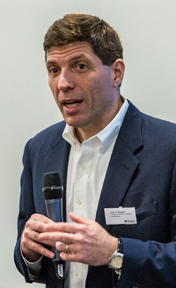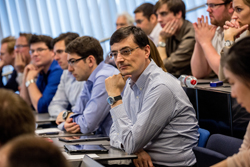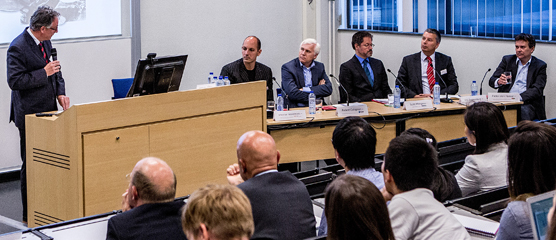Erasmus Management Lecture
Eric Bradlow: Big data? What new and better data means for business
While ‘big data’ are the words on everyone’s lips, it’s actually new and better data that will make a difference in managerial decision-making, said Professor Eric Bradlow at the Erasmus Management Lecture at Erasmus University Rotterdam on 26 May 2014.
Text Maaike Siegerist | Photos Chris Gorzeman
“Everybody thinks that big data is the answer,” said Professor Eric Bradlow, who is Co-Director of the Wharton Customer Analytics Initiative, an academic research centre in Pennsylvania, USA focusing on the development and application of customer analytic methods. “It’s not about big data. It’s about better data.”
“Most of the interesting problems that I see arise from new and better data that lead to big data, and therefore better management practice and better management science,” he told his audience of researchers and professionals.
The annual Erasmus Management Lecture is “a platform to learn about new developments in management,” explained ERIM’s Associate Director, <link people dennis-fok>Professor Dennis Fok. Professor Bradlow’s presentation was followed by a panel discussion by experts from business about the practical applications of new data.
New data, better data, big data
 Management science has come a long way since its humble beginnings in the 1950s, according to Professor Bradlow. Until the 1980s, researchers had to work with retail store-level data and could not adequately measure the effect of direct mailings. Only with the invention of store scanners did it become possible to track the actual behaviour of customers – what prices they paid and whether or not they used coupons. Still, that was merely the outcome of the purchasing process. It wasn’t until the emergence of the internet in the 1990s that retail analysts could see, by means of IP tracking, cookies and registered users, what pages and advertisements customers had looked at in the process of browsing.
Management science has come a long way since its humble beginnings in the 1950s, according to Professor Bradlow. Until the 1980s, researchers had to work with retail store-level data and could not adequately measure the effect of direct mailings. Only with the invention of store scanners did it become possible to track the actual behaviour of customers – what prices they paid and whether or not they used coupons. Still, that was merely the outcome of the purchasing process. It wasn’t until the emergence of the internet in the 1990s that retail analysts could see, by means of IP tracking, cookies and registered users, what pages and advertisements customers had looked at in the process of browsing.
“There’s an explosion of new data,” Professor Bradlow said. Online or offline, leading companies now build their business models one customer at a time. Businesses track the behaviour of individual customers to provide them with coupons and discounts in a targeted way, to send them e-mails at the appropriate time, and to reduce customer attrition, or ‘churn’ as marketers call it. For example, TripAdvisor, a travel website, has partnered with the social networking site Facebook to show users the reviews that matter to them – those written by their friends.
Future of management science
Professor Bradlow’s vision for the future of management science is that it will track exactly how customers move through stores and what they look at.
One his projects involves a technology called path-tracker: a system that tracks the route people take through a store. Every five seconds, the shopping carts broadcast signals which can be used to triangulate customers’ positions in the store. Linking location data to checkout data, the researchers can see where customers put products into their shopping carts. Interestingly, most people take a racetrack-shaped route through the store and go only halfway down one aisle, suggesting that shelf space in the middle of aisles is least valuable. Also, “people that browse more tend to shop more,” Professor Bradlow noted.
 Another research project focuses on eye-tracking. “You can now install cameras right into the shelf that focus and find customers’ retinas automatically and track what they’re looking at, while people are standing there,” according to Professor Bradlow. The optimal location for products is at a height of between 1.71 and 1.83 metres on the left side of a shelf – which can be explained by the height of our eyes and our reading direction. “This is not just big data, this is better data,” said the professor. “This is real people looking at real products.”
Another research project focuses on eye-tracking. “You can now install cameras right into the shelf that focus and find customers’ retinas automatically and track what they’re looking at, while people are standing there,” according to Professor Bradlow. The optimal location for products is at a height of between 1.71 and 1.83 metres on the left side of a shelf – which can be explained by the height of our eyes and our reading direction. “This is not just big data, this is better data,” said the professor. “This is real people looking at real products.”
His research also shows that if you look at a product for more than 50 milliseconds – that’s five hundredths of a second – you’re more likely to consider it and recall it later. You are also more likely to purchase it, although that effect is less pronounced. Finally, Professor Bradlow argued that in-store marketing is effective: in one study conducted in a supermarket, he found that “60 per cent of the purchases in the store were unplanned.”
Uses of better data by leading companies
Leading companies are already using new kinds of data to improve their business decisions, according to Professor Bradlow:
- Netflix, an online content provider, designs new television shows on the basis of the viewing history of groups of customers and the attributes or meta-tags of the videos they watched.
- Starbucks, a coffee company, doesn’t use discounts to reward loyal customers, but offers them to those customers who could become loyal.
- Amazon, an online retailer, ships items you’re likely to buy in the future to a warehouse near you, to minimise delivery time.
- American Express, a financial services corporation, harvests data from social media in order to reduce customer attrition and the risk of default.
- Kohl’s, a chain of value department stores, tracks customers’ whereabouts in stores and their activity on its website, in order to present targeted coupons at the right moment.
New data and scientific decision-making in business
After Professor Bradlow’s lecture, ERIM’s <link people eric-van-heck>Professor Eric van Heck moderated a discussion about implementing scientific decision-making based on new data, in practice. A panel of experts shared their experience.

Scientific decision-making, while important, would not be sufficient to ensure a company’s success, according to the panellists. “I think the best decisions are those that utilise the German Fingerspitzengefühl [literally ‘finger tips feeling’ – intuitive flair or instinct] and the evidence that we have,” said Pieter den Hamer, Manager Business Intelligence & Analytics at Alliander. The need for scientific decision-making is industry-dependent, added Scott Mongeau, Analytics Manager at Deloitte. Retailers and courier services gained a distinct strategic advantage by optimising their logistical processes, but companies in other sectors might not experience the same pressure. An additional problem is that the interpretation of data is not always straightforward, the panel members found.
The panellists argued that large, established companies are in a better position to reap the benefits from new data than start-ups. Maurice Hesselmans, Programme Manager Euromax Terminal at ECT, stressed that large companies have more funds and knowledge available, both of which are required to translate new data into practical solutions. ECT has an entire department dedicated to this process. In similar vein, Eric Zwanenburg, Account Manager Health Sciences at Oracle, argued that start-ups might do well in the IT industry, but that a challenge like personalising healthcare would be too daunting for a small company.
Translating insights from new data into business solutions might well be the biggest challenge of all. Robert Collignon, Senior Vice President Brand & Customer Strategy at Aegon, identified two key barriers in his company. The first is the internal business structure. Combining online and offline data “seems so easy, but it’s actually very difficult in real life,” according to Mr Collignon. The second barrier is people. Marketing managers have a hard time thinking and acting based on facts, while data scientists experience difficulty thinking creatively and working from business problems. Mr Collignon added: “That’s where we ultimately spend most of our energy, not so much on the analytics itself.” Indeed, creativity is a bottleneck in using new data, stressed Den Hamer of Alliander: “Big data is also about new business models – rethinking our current business processes and creating new business opportunities.” It’s clear that such wholescale rejuvenation of business thinking and practices will require creative thinking.


